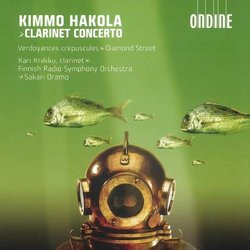| All Artists: Kimmo Hakola, Sakari Oramo, Finnish Radio Symphony Orchestra Title: Kimmo Hakola: Clarinet Concerto Members Wishing: 0 Total Copies: 0 Label: Ondine Original Release Date: 1/1/2006 Re-Release Date: 3/21/2006 Genre: Classical Styles: Chamber Music, Forms & Genres, Concertos, Historical Periods, Classical (c.1770-1830) Number of Discs: 1 SwapaCD Credits: 1 UPC: 761195106327 |
Search - Kimmo Hakola, Sakari Oramo, Finnish Radio Symphony Orchestra :: Kimmo Hakola: Clarinet Concerto
 | Kimmo Hakola, Sakari Oramo, Finnish Radio Symphony Orchestra Kimmo Hakola: Clarinet Concerto Genre: Classical
|
Larger Image |
CD Details |
CD ReviewsHakola is a lesser-known member of his great Finnish generat Christopher Culver | 12/04/2007 (4 out of 5 stars) "Kimmo Hakola (born 1958), is a member of that generation of Finnish composers and musicians who have taken the contemporary music by storm, figures like Magnus Lindberg, Kaija Saariaho, and Esa-Pekka Salonen. Nonetheless, he remains lesser-known due to his late start--he found his footing with the String Quartet No. 1 of 1986--and his comparatively small body of works. Nonetheless, as this 2005 Ondine disc reveals, he is a composer well-worth getting acquainted with. Hakola writes in the vein of "kinder, gentler modernism", but without falling into the trap of genericism. Sakari Oramo leads the Finnish Radio Symphony Orchestra.
The Concerto for Clarinet and Orchestra (2001) was written for Kari Kriikku, that clarinettist who has been the dedicatee of most major Finnish works for the instrument and who performs here. The first two movements give the clarinettist all the usual challenges of a modern-classical concerto pushing the boundaries of the instruments. The first movement is caffeinated music, where diverse movement in all parts of the orchestra is constantly interrupted by savage ostinatos. It resembles somewhat the best of Magnus Lindberg's music, and it is a pity that Lindberg himself went overly mellow with his own Clarinet Concerto two years later. The second movement is very slow and overtly melodic. Hakola says that it was inspired by the clarinet concerto of Mozart. While the first two movements had Hakola working on the basis of the classical and modernist traditions, the latter two show him going considerably further afield. The third movement is a rousing Oriental dance in 7/8 time. The fourth movement turns the concerto even further into the exotic. Taped sounds of reveling wedding guests opens the movement, and then the orchestra launches into what sounds very much like the Wedding cocek in Goran Bregovic's score for the film UNDERGROUND. These celebratory orchestral moments alternate with wistful Klezmer moments for clarinet solo. Now, this might sound like World music crossover gimmickry, but it isn't at all. The combination of these different elements makes a convincing synthesis, and doesn't get tired and stale with repeated listening. At forty minutes, the concerto takes up most of the disc, but Ondine has included two shorter pieces to fill it out. "Diamond Street" for clarinet solo (1999) is a 7-minute sketch for the concerto, a first exploration of the extended techniques of the instrument. The 13-minute "Verdoyances crépuscules" for orchestra (2003) lacks outright reference to other world musical directions, but nonetheless retains a clarity of line. Hakola shows himself a master orchestrator, and within this general ensemble work all the various members are given their moment in the spotlight." |

 Track Listings (6) - Disc #1
Track Listings (6) - Disc #1